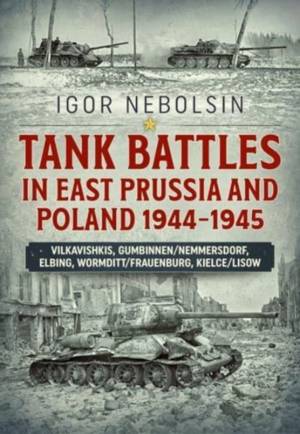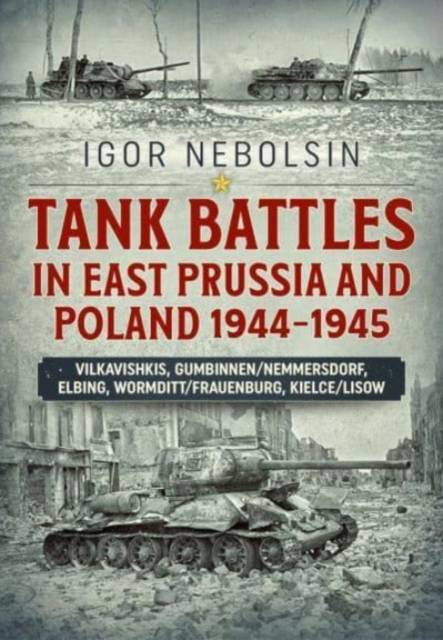
- Retrait gratuit dans votre magasin Club
- 7.000.000 titres dans notre catalogue
- Payer en toute sécurité
- Toujours un magasin près de chez vous
- Retrait gratuit dans votre magasin Club
- 7.000.000 titres dans notre catalogue
- Payer en toute sécurité
- Toujours un magasin près de chez vous
Tank Battles in East Prussia and Poland 1944-1945
Vilkavishkis, Gumbinnen/Nemmersdorf, Elbing, Wormditt/Frauenburg, Kielce/Lisow
Igor Nebolsin
Livre broché | Anglais
48,95 €
+ 97 points
Format
Description
This new study by Igor Nebolsin covers, in remarkable detail, a number of forgotten and overlooked armored engagements on the Eastern Front during the final year of the war, based firmly on Soviet and German archival records.
After defeating German Group Army Centre in Belorussia (Operation Bagration) in the first days of August 1944 the Red Army rapidly approached East Prussia. Here, near the borders of the Third Reich in the area of Vilkavishkis heavy tank combats broke out. German Panzer-Grenadier Division Großdeutschland engaged the Soviet 33rd Army, reinforced by the 2nd Guards Tank Corps and separate Anti-tank artillery Brigades and Regiments, in fierce and extensive combat. Based on the archival documents from both sides and other sources Igor Nebolsin provides a meticulous analysis of this battle and challenges myths created by some German authors.
By mid-October 1944 the Soviet 3rd Belorussian Front was ready to invade East Prussia. 2nd Guards Tank Corps committed to the main axis of attack developed an operational breakthrough in the direction of Gumbinnen and soon captured an important crossing over the Angerapp River at Nemmersdorf. For two days Soviet units were engaged in severe fighting against Fallschirm-Panzer-Division Hermann Göring, 5th Panzer Division and the Führer-Begleit-Brigade. Combat in East Prussia were notable, even by Eastern Front standards, for their severity, mercilessness and heavy losses in personnel and material for both sides.
In January 1945 the Red Army managed to break the strong German defense in East Prussia and swiftly reached the Baltic, cutting off East Prussia from Germany. 5th Guards Tank Army played a decisive role in this breakthrough. At the final stage of this operation the Army contained a desperate attempt of the German 4th Army to escape from East Prussia to Germany in tank engagements at Wormditt and Frauenburg.
This book also covers tank battles near Kielce, Poland in January 1945 where XXIV Panzer Korps (16th Panzer Division, 17th Panzer Division, 20th Panzer-Grenadier Division, 424th Schwere-Panzer-Abteilung) was engaged in an engagement lasting three days against forces of the Soviet 4th Guards Tank Army.
The day-by-day coverage of events, honest views of the Soviet and German commanders, statistical data from both Russian and German viewpoints, and the 'human element' based on the exciting first-hand reminiscences of Soviet tank officers all make this study an incredibly valuable source of information. The text is fully supported by specially-commissioned color maps and an extensive selection of photographs, many from private collections.
After defeating German Group Army Centre in Belorussia (Operation Bagration) in the first days of August 1944 the Red Army rapidly approached East Prussia. Here, near the borders of the Third Reich in the area of Vilkavishkis heavy tank combats broke out. German Panzer-Grenadier Division Großdeutschland engaged the Soviet 33rd Army, reinforced by the 2nd Guards Tank Corps and separate Anti-tank artillery Brigades and Regiments, in fierce and extensive combat. Based on the archival documents from both sides and other sources Igor Nebolsin provides a meticulous analysis of this battle and challenges myths created by some German authors.
By mid-October 1944 the Soviet 3rd Belorussian Front was ready to invade East Prussia. 2nd Guards Tank Corps committed to the main axis of attack developed an operational breakthrough in the direction of Gumbinnen and soon captured an important crossing over the Angerapp River at Nemmersdorf. For two days Soviet units were engaged in severe fighting against Fallschirm-Panzer-Division Hermann Göring, 5th Panzer Division and the Führer-Begleit-Brigade. Combat in East Prussia were notable, even by Eastern Front standards, for their severity, mercilessness and heavy losses in personnel and material for both sides.
In January 1945 the Red Army managed to break the strong German defense in East Prussia and swiftly reached the Baltic, cutting off East Prussia from Germany. 5th Guards Tank Army played a decisive role in this breakthrough. At the final stage of this operation the Army contained a desperate attempt of the German 4th Army to escape from East Prussia to Germany in tank engagements at Wormditt and Frauenburg.
This book also covers tank battles near Kielce, Poland in January 1945 where XXIV Panzer Korps (16th Panzer Division, 17th Panzer Division, 20th Panzer-Grenadier Division, 424th Schwere-Panzer-Abteilung) was engaged in an engagement lasting three days against forces of the Soviet 4th Guards Tank Army.
The day-by-day coverage of events, honest views of the Soviet and German commanders, statistical data from both Russian and German viewpoints, and the 'human element' based on the exciting first-hand reminiscences of Soviet tank officers all make this study an incredibly valuable source of information. The text is fully supported by specially-commissioned color maps and an extensive selection of photographs, many from private collections.
Spécifications
Parties prenantes
- Auteur(s) :
- Editeur:
Contenu
- Nombre de pages :
- 546
- Langue:
- Anglais
Caractéristiques
- EAN:
- 9781914059612
- Date de parution :
- 15-12-21
- Format:
- Livre broché
- Format numérique:
- Trade paperback (VS)
- Dimensions :
- 170 mm x 244 mm
- Poids :
- 1270 g







